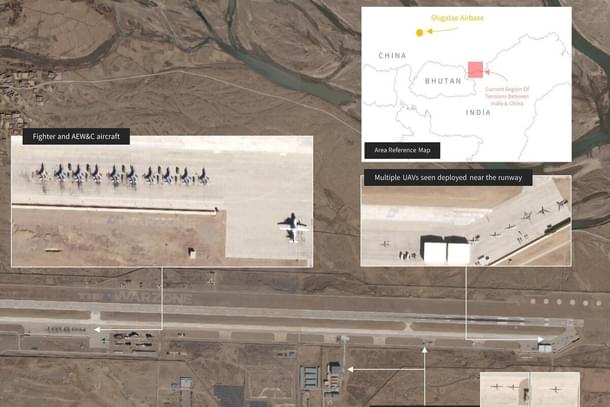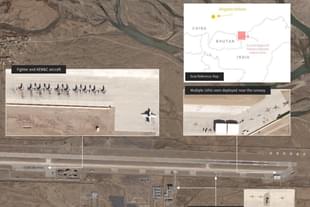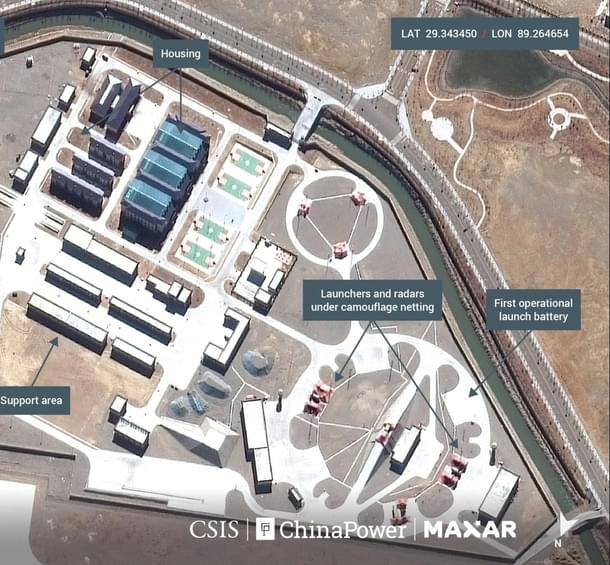News Brief
Tawang Clash: Satellite Images Of China's Newly Upgraded Shigatse Air Base Near Arunachal Show Presence Of Fighters, Drones
Swarajya Staff
Dec 14, 2022, 03:43 PM | Updated 04:55 PM IST
Save & read from anywhere!
Bookmark stories for easy access on any device or the Swarajya app.


In the weeks leading up to the clashes in Arunachal's Tawang, the Indian Air Force (IAF) had to scramble its Su-30 MKI fighters to deter Chinese drones from approaching Indian positions along the Line of Actual Control.
The latest satellite images of China's dual-use Shigatse Airport show that the People's Liberation Army Air Force (PLAF) has maintained a large deployment of fighter and unmanned aerial vehicles at the base.
The airport, located around 150 kilometers north of India's frontier with Tibet, has a runway stretching 5,000 meters. It is the third longest runway in the world, a report by the China Power Project at the Center for Strategic and International Studies says.
Chinese air bases on the Tibetan Plateau have some of the longest runways in the world. The payload capabilities of a fighter degrade significantly when it takes off from bases at high altitudes. Long runways at bases in Tibet help the PLAAF to deal with this handicap, which the Indian Air Force, with most of its bases in the plains, does not have to face.
Satellite images of the Shigatse Airport show a large detachment of fighters, UAVs, air refuelers, and early warning aircraft.

However, the presence of fighters and UAVs at Shigatse is not surprising or unusual as China has maintained such military assets at the base for years.
"The air base typically hosts numerous military assets—including fighter jets, helicopters, and unmanned aerial vehicles—capable of launching air attack and reconnaissance missions into neighboring territory," the China Power Project report published earlier this year says.
Earlier this year, J-11 multirole fighter jets and WZ-7 Xianglong (Soaring Dragon) drones of the PLAAF were seen at the base.
"WZ-7 Xianglong...a high-altitude, long-endurance reconnaissance drone. It has been in service in the PLAAF since at least 2018, and has been spotted at Shigatse and other bases in the PLA's Western Theater Command, including Malan air base in Xinjiang," the report adds.
But experts have pointed out that the "uptick in the AEW (airborne early warning) aircraft" at Shigatse is "notable."
The AEW aircraft will provide the PLAAF with a better picture of the activity in the airspace along the LAC, along with early detection of threats.
"Indian media has reported an increase in Chinese aerial platforms, including UAVs, moving towards the border recently forcing the IAF to deploy reciprocally. It is likely that the Shigatse Airport is acting as the main forward base supporting these Chinese air missions in the region," a report by TheWarZone and open-source intelligence analyst @detresfa says.
The Shigatse air base has seen significant upgrades in the last few months.
For instance, satellite imagery from January this year shows an existing base of surface-to-air missiles being renovated and expanded.

China is also working on a rail line around 2 kilometers from the air base. The rail line could be used for transporting the equipment landing at the base to the frontier with India in the event of a conflict.
"In this area, a new rail line has been built, along with three railway terminals. These terminals appear to be capable of loading and unloading large equipment—including military equipment—onto and off of the railway," the China Power Project report notes.

"Immediately west of the new rail line, work is ongoing at multiple areas to construct a large underground facility (UGF) within a small mountain formation. Over the years, the PLA has been known to house command and control and logistics facilities, nuclear and conventional missile systems, and even strategic naval forces within UGFs," it adds.
Follow the latest developments with Swarajy's Tawang clash tracker.





